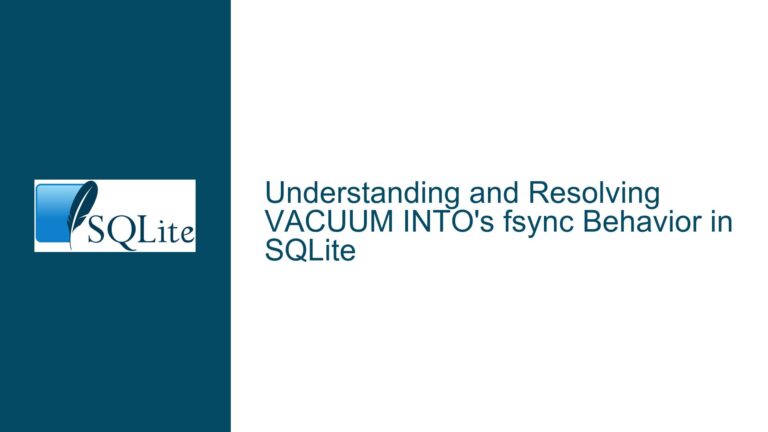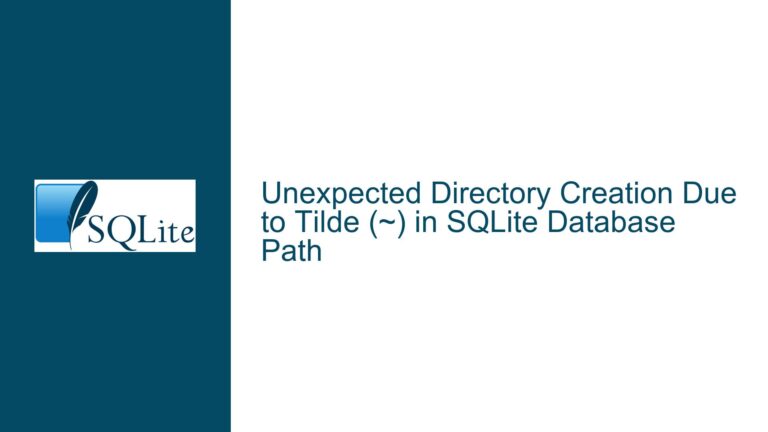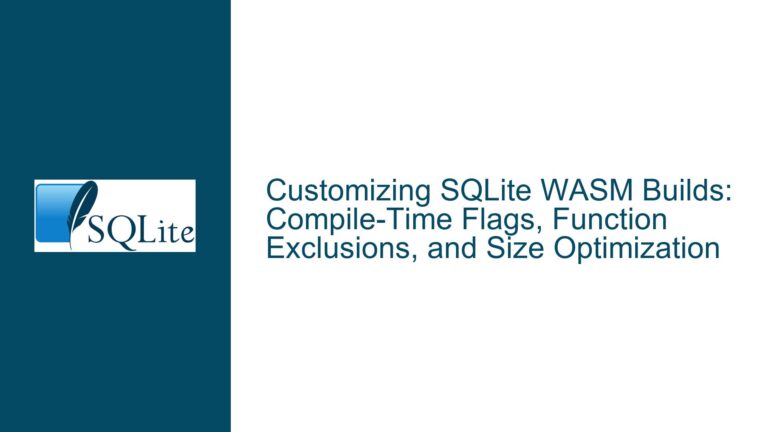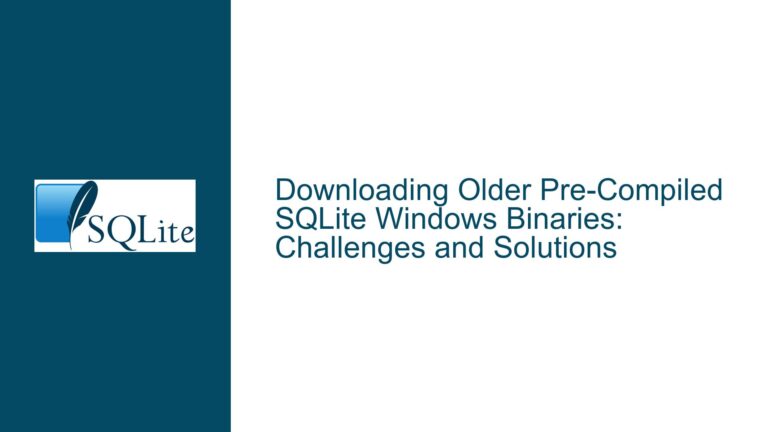VACUUM Command Fails in SQLite with User Authentication Extension Enabled
VACUUM Operation Failure Due to User Authentication Extension
The VACUUM command in SQLite is a crucial maintenance operation that rebuilds the database file, repacking it into a minimal amount of disk space. This operation is particularly useful for optimizing database performance and reclaiming unused space. However, when the SQLite User Authentication Extension is enabled, the VACUUM command can fail, leading to errors that prevent the database from being optimized. This issue arises due to the interaction between the VACUUM command’s internal mechanisms and the security constraints imposed by the User Authentication Extension.
The core of the problem lies in how the VACUUM command operates. When VACUUM is executed, SQLite creates a temporary database (vacuum_db) to which it copies all the data from the main database. This temporary database is then used to rebuild the main database file. However, when the User Authentication Extension is enabled, the temporary database (vacuum_db) is subject to the same authentication rules as the main database. This means that the VACUUM operation must also authenticate against the temporary database, which leads to a series of complications.
The primary error encountered is the absence of the sqlite_user table in the temporary database. The sqlite_user table is a critical component of the User Authentication Extension, as it stores user credentials and access rights. When the VACUUM command attempts to copy data from the main database to the temporary database, it tries to include the sqlite_user table. However, since the temporary database is newly created and does not yet have this table, the operation fails with an error indicating that the sqlite_user table does not exist in the temporary database.
This issue is further compounded by the fact that the User Authentication Extension does not currently support the creation of temporary databases without proper authentication. The extension’s design assumes that any database operation, including those involving temporary databases, must be authenticated. This assumption creates a conflict with the VACUUM command’s requirement to create and manipulate a temporary database without the same level of authentication as the main database.
Interrupted Write Operations Leading to Index Corruption
The failure of the VACUUM command in the presence of the User Authentication Extension can be traced back to several underlying causes. The most significant of these is the extension’s handling of temporary databases. The User Authentication Extension was designed with the assumption that all database operations, including those involving temporary databases, would be subject to the same authentication rules as the main database. This design choice was likely made to ensure that no unauthorized access could occur, even during maintenance operations like VACUUM.
However, this design choice creates a conflict with the VACUUM command’s internal mechanisms. The VACUUM command relies on the ability to create and manipulate a temporary database without the same level of authentication as the main database. This is because the temporary database is used solely for the purpose of rebuilding the main database and does not contain any sensitive data. The User Authentication Extension’s requirement that the temporary database be authenticated prevents the VACUUM command from completing its task, leading to the observed errors.
Another contributing factor is the age and lack of recent development on the User Authentication Extension. The extension is nearly seven years old and has not received significant updates or attention in recent years. This lack of development has likely contributed to the extension’s incompatibility with newer SQLite features, such as the current implementation of the VACUUM command. The extension’s test suite does not include tests for VACUUM functionality, which means that this issue may have gone unnoticed until now.
Additionally, the User Authentication Extension’s implementation contains a flaw in the userAuthCheckLogin function. This function is responsible for checking whether a database has a sqlite_user table. However, the function currently checks for the existence of the sqlite_user table in the "main" database, rather than the database specified by the zDb parameter. This flaw causes the function to incorrectly assume that the sqlite_user table exists in the temporary database, leading to further errors when the VACUUM command attempts to copy data from the main database to the temporary database.
Implementing PRAGMA journal_mode and Database Backup
To address the issue of the VACUUM command failing in the presence of the User Authentication Extension, several steps can be taken. The first and most straightforward solution is to modify the User Authentication Extension to allow temporary databases to be created and manipulated without requiring authentication. This change would involve updating the extension’s code to recognize temporary databases and exempt them from the usual authentication requirements. This approach would allow the VACUUM command to complete its task without encountering the errors related to the sqlite_user table.
One way to implement this change is to modify the userAuthCheckLogin function to correctly check for the existence of the sqlite_user table in the specified database (zDb), rather than always checking the "main" database. This change would ensure that the function behaves as intended and does not incorrectly assume that the sqlite_user table exists in the temporary database. The modified code would look like this:
if( !userTableExists(db, zDb) ){
*peAuth = UAUTH_Admin; /* No sqlite_user table. Everybody is admin. */
return SQLITE_OK;
}
This change would allow the VACUUM command to create and manipulate the temporary database without encountering errors related to the sqlite_user table.
Another potential solution is to use the PRAGMA journal_mode command to change the journaling mode of the database before executing the VACUUM command. The PRAGMA journal_mode command controls how SQLite handles transaction logging, which can affect the database’s performance and reliability. By setting the journal mode to OFF or MEMORY before executing the VACUUM command, it may be possible to avoid some of the issues related to the User Authentication Extension. However, this approach should be used with caution, as it can affect the database’s ability to recover from crashes or power failures.
In addition to modifying the User Authentication Extension and using PRAGMA journal_mode, it is also important to implement a robust database backup strategy. Regular backups can help mitigate the risks associated with database corruption or other issues that may arise during maintenance operations like VACUUM. SQLite provides several tools for creating backups, including the .backup command in the SQLite shell and the sqlite3_backup API in the SQLite C interface. These tools can be used to create full or incremental backups of the database, which can be restored in the event of a failure.
Finally, it is worth considering whether the User Authentication Extension is the best solution for your specific use case. While the extension provides a simple way to add user authentication to a SQLite database, it may not be suitable for all applications. If your application requires more advanced user management or access control, you may want to consider using a different database system, such as MySQL or PostgreSQL, which provide more robust support for multi-user environments. However, if you prefer to stick with SQLite, you may need to implement your own user authentication and access control mechanisms, either by extending the existing User Authentication Extension or by building a custom solution from scratch.
In conclusion, the failure of the VACUUM command in the presence of the SQLite User Authentication Extension is a complex issue that requires careful consideration of the extension’s design and implementation. By modifying the extension to allow temporary databases to be created and manipulated without authentication, using PRAGMA journal_mode to change the journaling mode, and implementing a robust database backup strategy, it is possible to overcome this issue and ensure that your SQLite database remains optimized and secure.






